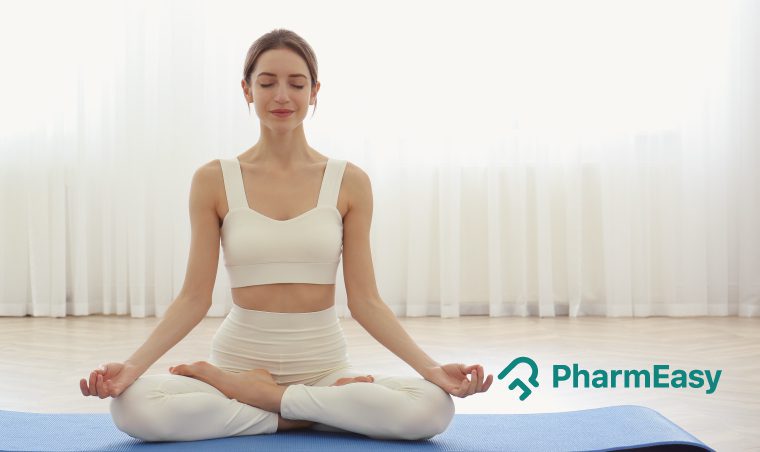Benefits of Padmasana and How to Do it By Dr. Himani Bisht
By Dr. Himani Bisht +2 more

Get,

to manage your symptom
Get your,


4 Cr+ families
benefitted

OTP sent to 9988776655



You’ve successfully subscribed to receive
doctor-approved tips on
Whatsapp

Get ready to feel your best.

Hi There,
Download the PharmEasy App now!!


Register to Avail the Offer
Send OTPBy continuing, you agree with our Privacy Policy and Terms and Conditions

Hi There,
Sign up on PharmEasy now!!
Trusted by 4 crore+ families

OTP sent to 9988776655



You have unlocked 25% off on medicines




Code: NU25
By Dr. Himani Bisht +2 more
Table of Contents
Yoga, as mentioned in various Vedas and Upanishads, focuses on meditation, avoiding worldly attachments, and attaining harmony between our body, mind, and soul. This definition of yoga is completely different in the modern world, especially in Western countries that focus on techniques that are posture-based targeting physical fitness and relaxation1.
It is quite interesting to see how ancient amalgamates with modern bringing a beautiful product that is much in demand these days!1 Yoga helps in the integration of the internal environment with the external environment so a harmony is achieved in all possible aspects2. Asanas or postures have gained recognition and admiration as one of the potential approaches to gaining holistic health.

Did You Know?
Padmasana [pɑd-mɑ-sɑ-nɑ] is also known as Lotus pose4.
It is an ancient Indian practice, where a person sits in a cross-legged posture placing his/her feet on the opposite thighs. Lotus pose is an established meditative asana in Hindu, Jain and Buddhist traditions. Padmasana allows the body to be held completely steady for a longer period5.
Those who feel that the full lotus pose is intense can practice the easier version of Padmasana. In this variation, only one foot is put at the top of the opposite keeping the other foot under the out-stretched thigh. This version is known as the Ardh-Padmasana or Half-Lotus pose4.
Padmasana helps students in focusing and diminish stress, especially during exams. It holds the wandering thoughts and stabilizes the mind. The steadiness and calmness are the real steps toward meditation2. The lotus pose also encourages the digestive process and tones sacral nerves (nerves that provide control to the pelvis and legs) by increasing the flow of blood3.
Let me tell you this particular yoga pose not only helps with constipation. It might also come to your rescue in indigestion and gas. By practising this asana, you find relief from that uncomfortable feeling of excess gas in your tummy. It might just be the natural remedy you’ve been looking for!
Dr. Rajeev Singh, BAMS
To attain maximum health benefits and maintain proper posture, it is essential to follow proper techniques. Christopher Hutton (2014), in his research paper on “Benefits of Yoga Pranayama, Asana, and Meditation Techniques for Classically Trained Singers and Voice Educators” mentions that getting into the lotus pose involves four steps:
The elbows can be slightly bent but the shoulder should not be hunched or elevated. The position can be held as long as the person feels comfortable with eyes closed, thus relaxing the whole body. Essential arrangements like moving forward and backward, should be made to maintain the alignment and balance with accurate posture2,4.
In my opinion, sitting in Padmasana during yoga practice might increase your energy levels. According to a study7, experienced male yoga practitioners who sat in Padmasana for 30 minutes showed higher energy levels when measured by acupuncture. These findings highlight the possible stimulating effects of Padmasana on our subtle energy.
Dr. Smita Barode, B.A.M.S, M.S.
Padmasana has several benefits that help enhance physical, mental and spiritual health. Some of them are:
Kumar et al. 2017 mention the study involving 20 patients with diabetes (increased glucose level) subjected to 40 days of yoga, involving Padmasana as one of the postures, which showed a decrease in glucose levels and an increase s in insulin levels3.
Padmasana helps in diminishing the pain of leg and knee joints related to Arthritis (swelling of joints). It also helps in delaying the process of Genu valgum (a condition where knees touch each other while ankles remain apart) caused by arthritis5.
The lotus posture helps in distributing the pressure on the lower spine, thus allowing the body to be steady for a longer time. It helps in securing the base of the body by gripping the trunk and head2.
Padmasana helps in relieving constipation and improves the digestive process. The usual blood flow to the legs is diverted to the abdominal region, aiding digestion2,3. The improvement in the digestive process may help in maintaining body weight.
Padmasana may help in stabilizing the body. Once the body is stabilized, the mind becomes calm. This posture relieves the tight muscles surrounding the spine, thus helping to relax and flush out the negative thoughts of the mind, which may help in calming the nervous system2.
Padmasana or lotus pose is a spine-lengthening asana that may aid in providing a balanced posture to individuals. Singers are recommended to have balanced postures for healthy singing. Improper body alignment might affect lungs restricting overall freedom of voice2.
Before starting yoga, always consult a qualified doctor who can assess your physical condition correctly and advise accordingly. Moreover, it is necessary to practice and learn yoga under the supervision of a trained yoga teacher to avoid any injuries.
Let me give you a heads-up about Padmasana. It may be better to avoid doing this during pregnancy. Do you know why? Well, when you sit in Padmasana, the circulation in your legs might get reduced. And that’s not something we may want during pregnancy.
Dr. Siddharth Gupta, B.A.M.S, M.D (Ayu)
Also Read: Benefits of Vayu Mudra and How to Do it By Dr. Ankit Sankhe
Some of the contraindications related to Padmasana or Lotus pose are:
With the guidance of a qualified yoga teacher, we can access and analyze the risk factors and continue to practice Padmasana.
Also Read: Benefits of Anulom Vilom and How to Do it By Dr. Ankit Sankhe
The Padmasana or lotus pose is described as beneficial for physical and spiritual well-being in ancient literature. The flow of prana (breath) in the Padmasana from the pelvis (area between the abdomen and thighs) to the head amplifies the experience of meditation. The pressure on the lower spine during the lotus pose calms the nervous system. The asana or posture may be recommended and encouraged to attain the best standard of living.
Also Read: Benefits of Vrikshasana (Tree Pose) and How to Do it By Dr. Ankit Sankhe
The name Padmasana is a Sanskrit word where the Padma is “Lotus” and asana is “posture or sitting”. It is also called as “seat of the lotus flower”. It is a religious meditation posture, especially utilized by yogis and sadhus in India6.
The Padmasana is usually the seated asana, where legs are folded with the soles of feet facing towards the sky. It is an ancient Indian established asana in Hindu, Buddhist, and Jain traditions for maintaining steadiness for a longer period5,6.
A person suffering from knee injury, sciatica, and sacral infections are not allowed to do Padmasana. This asana should always be practiced after knee warm-up exercise for better and more effective results2,5.
There are mainly four steps involved in Padmasana. The first position is to sit with legs extended outward and lengthening the spine from the lower end to the top of the head. Then slowly bring one foot on top of the other stretched thigh. The sole should face towards the sky and the heel towards the navel adjacent to the pubic bone. Repeat the same steps with the second foot on the opposite thigh. Concentrate on the breath moving from the abdomen, up the spine to the head. The position is held as long as the person is comfortable4.
Disclaimer: The information provided here is for educational/awareness purposes only and is not intended to be a substitute for medical treatment by a healthcare professional and should not be relied upon to diagnose or treat any medical condition. The reader should consult a registered medical practitioner to determine the appropriateness of the information and before consuming any medication. PharmEasy does not provide any guarantee or warranty (express or implied) regarding the accuracy, adequacy, completeness, legality, reliability or usefulness of the information; and disclaims any liability arising thereof.
Comments

Leave your comment...
You may also like
Comments